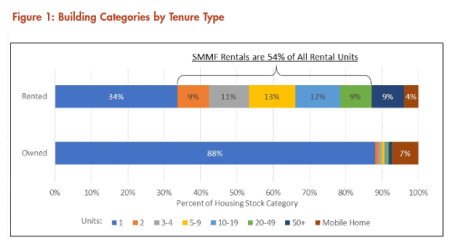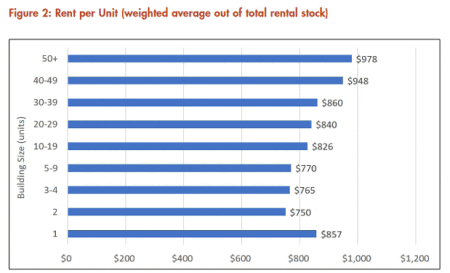Large, luxury apartment and condo developments have been dominating headlines and casting a big shadow over the “little guys” in rental housing. A new report released by Enterprise Community Partners and Bedrosian Center on Governance at the University of Southern California (USC) aims to call attention to this overlooked segment of the market.
Understanding the Small and Medium Multifamily (SMMF) Housing Stock emphasizes the formidable size of this segment of the market and its importance as a source of naturally occurring affordable rental housing. SMMF properties with two to 49 units account for more than half (54 percent) of all rental housing in the United States, according to the report. Many of these properties were originally built in the 1960s, 1970s, and 1980s. That aging inventory, along with limited amenities in many cases, contributes to lower average rental rates compared with those obtained by its larger, newer competitors.
“The SMMF sector currently, and in the future, will act as a relief valve due to its relatively affordable nature in urban and suburban areas and in small towns,” says Seva Rodnyansky, one of the report authors and a PhD candidate in urban planning and development in the Price School of Public Policy at USC.
One goal of the report is to encourage policy makers to support the development of financial tools to preserve existing properties as they age and reduce barriers to production of new SMMF properties. Some buildings are aging and dropping out of the market due to redevelopment, and the concern is that those units are not being replaced with similar building types, notes Rodnyansky. SMMF accounted for more than a quarter of all units built in the 1970s and 1980s, but since 1990 it has represented only about 15 percent of new construction, according to the report.
Developers Face Big Obstacles
The report underscores the challenges that exist to develop new small and medium-sized rental properties in many metro areas, notes Stockton Williams, executive director of ULI’s Terwilliger Center for Housing. “That is problematic, because there is real demand for that kind of missing, middle-market housing in various configurations,” he says.
It has become much less economical for the development community to produce small and even medium-sized apartment communities in many cities. From the developer’s perspective, building large, high-end and luxury apartment projects is delivering the best competitive return on investment. “The other side of the coin is that there has been substantial demand for Class A and luxury apartment units in larger, typically more urban settings,” says Williams.
Given rising construction and land costs, many developers aim to maximize density and scale in order to make the numbers work. “Overall, a 50-unit project requires about the same amount of development work to execute as a 150-unit project, but the margins for the developer on the 50-unit project are lower and the cap rates/valuations are also generally lower,” says Curt Gunsbury, owner of the Solhem Companies, a Minneapolis-based developer that specializes in building sustainable residential properties.
The smallest apartment project that Solhem has completed is the 48-unit Cozē Flats, which opened in 2014. That project worked financially only because the site was sloped in a way that allowed for a very inexpensive underground garage and foundation system, and it also had superior views that commanded high rents, says Gunsbury.
Solhem is currently evaluating a 60-unit project in Minneapolis that likely will not work financially due to a requirement to include first-floor retail that would significantly lower the gross rents for the project. The project also has contaminated soils that will require remediation. “Small projects have a hard time paying their way in a cost and regulatory environment that requires such a high level of developer sophistication, capital, and risk,” says Gunsbury.
Changing the Regulatory Environment
The report makes a strong argument for the important role that SMMF properties play in providing a more affordable housing option. Properties with more than 50 rental units command the highest average rents at $978 per month. Specific to SMMF properties, average rents decline along with the size of the properties. Properties with 40 to 49 units reported average rents at $948 compared with rentals with two units that averaged rents of $750, according to the report. The sector also accounts for 56 percent of all subsidized units, according to the report.
Certainly, the smaller size of a property does not automatically dictate affordability. Location and land prices also factor into the equation, and some smaller apartments do charge high rental rates. “However, advocates of affordable and workforce housing are hopeful that if some of the barriers to producing more small and medium-sized properties can be removed that there will be new development of properties in that size that will serve a broader range of price points,” says Williams.
The regulatory environment is one of the major impediments to SMMF development. Securing the necessary city approvals and entitlements can be more time consuming and complex. Many cities also have new energy codes, parking fees, and higher standards related to exterior finishes—all of which can add time and cost to a project and affect rental rates.
“Clearly, policy is going to have to be part of the solution to making it viable for the private sector to produce more small and medium-sized properties,” says Williams. The public sector also can provide financial and other development incentives for the kinds of projects that it wants to support. “So, really being creative with that at the local level, and potentially at the state and federal level, is an opportunity, and I think the report does a service in pointing that out,” he adds.







